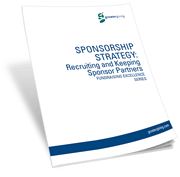
 This post is the third in a series designed to open you up to a new way of viewing sponsors and their role within your nonprofit’s overall strategy. These posts are based on the “Sponsorship Strategy: Recruiting and Keeping Sponsor Partners” eBook from the Greater Giving Fundraising Excellence Series. Each new post focuses on a different part of your sponsor strategy and how best to leverage your value for the greatest mutual benefit. View all released series articles—Sponsorship Strategies
This post is the third in a series designed to open you up to a new way of viewing sponsors and their role within your nonprofit’s overall strategy. These posts are based on the “Sponsorship Strategy: Recruiting and Keeping Sponsor Partners” eBook from the Greater Giving Fundraising Excellence Series. Each new post focuses on a different part of your sponsor strategy and how best to leverage your value for the greatest mutual benefit. View all released series articles—Sponsorship Strategies
What is corporate altruism?
Corporate altruism is often synonymous with social responsibility—which can include charitable giving, encouraging or requiring volunteerism from company employees, and/or developing in-house philanthropic programs.
In the past, the prevailing wisdom said that corporations who practice social responsibility do so at the expense of profit. Charitable giving may improve a company’s image, but it doesn’t return more to stockholders.
But new research indicates that corporate altruism might not have the significantly negative impact on profits once thought. Corporate altruism is a complex system that isn’t easily quantified, and if the philanthropy budget is spent wisely, it provides big business benefits.
Why do corporations practice altruism?
We usually assume businesses use charitable giving to engage with the community and improve their brand image within that community. Philanthrophy traditionally was a way to offset a negative brand image and bring new business—and by extension, boost revenue. Customers are more likely to buy from companies they view as “socially responsible.”
But companies are also now using altruism to improve employee hiring, retention and satisfaction. Today, many employees are looking for more than just a paycheck in their employment search; many are even willing to even take pay cuts in order to work for nonprofits or businesses with values more like their own. A positive social impact has become a much larger draw for good employees, and the feeling of being a part of something better keeps employees around longer.
Giving back builds a better community foundation.
Not all corporate altruism functions purely for improving a business’s image, or even retaining employees. Even unseen altruism serves a very specific purpose: keeping the communities a business depends on robust and able to spend dollars.

Without customers, there is no revenue; without employees, there is no business. Creating wealth and prosperity within a community ensures the longevity of the companies that serve it.
How do nonprofits capitalize on the spirit of altruism?
Keeping all this in mind, we’ve created a formula to help nonprofits narrow down their list of potential sponsors to the best-fit matches.
Does it make business sense? If a partnership with your nonprofit makes good business sense, it benefits the business directly—such as developing the audience that the business depends on for revenue. Look for places where your mission and your potential sponsor’s mission align, and capitalize on them in your pitch.
Do you and your potential sponsor share the same goals? For a nonprofit that focuses on literacy, for example, courting a bookseller would make great business sense. Increasing community literacy also increases the audience for books.
Does your sponsor have a new product or service coming out that could use a push? Position your nonprofit as part of a greater marketing campaign to get that new service or product in front of a greater audience—your audience.
Does it improve brand image? Is your nonprofit positioned to improve the potential sponsor’s image within in the target community? Ask yourself some of these questions:
- Who is this business’s target audience?
- Do you have the ability to tap into that target audience?
- Does that target audience carry trust in your organization?
Perhaps you and the business both serve the same group—in which case, that business’s name appearing on your sponsor list will certainly paint that business in a positive light to their target demographic. Consumer research shows that people prefer to give their business to companies and corporations that practice social responsibility and charitable giving. If your organization carries positive brand image within that community, some of that brand image is transferred to businesses who choose to sponsor you.
Also consider the value of your connections within a target community (such as your board members). Do you have direct access to decision-makers in local politics? If you’re courting a business-to-business type sponsor (as opposed to a direct-to-consumer sponsor), connections to other businesses within the consumer chain can be valuable leverage in your pitch.
Does it fulfill a desire for altruism? There are some simple, tangible benefits that businesses receive from altruism—benefits that pay off immediately:
- Tax write-offs: These can be huge incentives towards the end of the year.
- Employee satisfaction and retention: A robust CSR program not only gives employees the sense that their employer does good within the community, but engaging employees in volunteer work is itself rewarding. Studies find that once the initial hurdles to volunteerism are overcome, people find “doing good” to be addictive. A robust community engagement program can find its own legs and give employees an additional sense of purpose and meaning, and keep them around longer.
- Demonstrating altruism to customers and shareholders. Most people are coming to understand the vital connection between positive brand image and consumer success. Altruism demonstrates to shareholders that the business seeks a positive brand image among potential customers, which leads to increased revenue.
- Entertainment. Participating in nonprofit events, such as a big annual gala, is a great way to entertain big customers, employees, shareholders, and other business connections.
Before approaching a sponsor at all with a pitch, evaluate where your nonprofit falls in each of these categories. If you can fulfill some of a potential sponsor’s altruistic needs, they qualify as a good fit sponsor.
Once you’ve done all that soul-searching, you’re ready to craft your pitch around the fantastic value your nonprofit has to offer.
To continue reading about this subject, download the free Sponsorship Strategies eBook.

